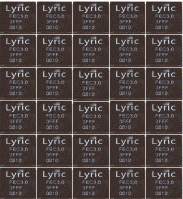Lyric Semiconductor has introduced an error correction component for flash memory that offers a 30X reduction in die size, a 12X improvement in power consumption and a significantly higher throughput compared to current platforms.
“[We have] developed an alternative to digital computing and are redesigning processing circuits from the ground up to natively process probabilities – from the gate circuits to the processor architecture to the programming language,” Lyric CEO Ben Vigoda told TG Daily.

”As a result, many applications that currently require a thousand conventional processors will soon run on just a single Lyric processor, providing 1,000X efficiencies in cost, power and size.”
Vigoda explained that computers have been based on digital computing principles for over 60 years – with data represented as bits (1s and 0s).
“Yes, Boolean logic gates perform operations on these bits. But Lyric invented a new kind of logic gate circuit that uses transistors as dimmer switches instead of as on/off switches.
“These circuits can accept inputs and calculate outputs that are between 0 and 1, directly representing probabilities, or levels of certainty.”
According to Vigoda, a typical digital processor “steps through” such operations serially to perform a specific function. However, Lyric’s processors (and accompanying software) are designed to perform multiple probability computations in parallel.
This approach can also be used to accelerate search results, fraud detection, spam filtering, financial modeling and genome sequence analysis.
“These are all applications that involve simultaneously considering many possible alternatives and deciding on the best fit – the best guess for the answer.
“Sure, in theory, digital processors can perform the same calculations, but in practice, they do so very inefficiently. As a result, a huge amount of processing overhead is required, costing an enormous amount of space, power and money.”

Vigoda noted that flash error rates were a prime example of how a traditional digital technology had become “increasingly problematic” and required an alternative approach.
“Today, one in every thousand bits stored in a flash memory comes out wrong when the memory is read. In the next generation, the number of errors will approach one bit wrong in every hundred.
“So, flash companies spend billions of dollars on new foundry processes in order to increase overall flash density, but then suffer from increasing error rates. As as a result, ‘advanced’ error correctors have had to become significantly larger, more complex and more expensive.
“But LEC – which is Lyric’s first commercial probability processing offering – features an advanced error corrector for flash memories that is 30X smaller and has 12X lower power consumption, all at a higher bandwidth than the digital implementations currently available.”






